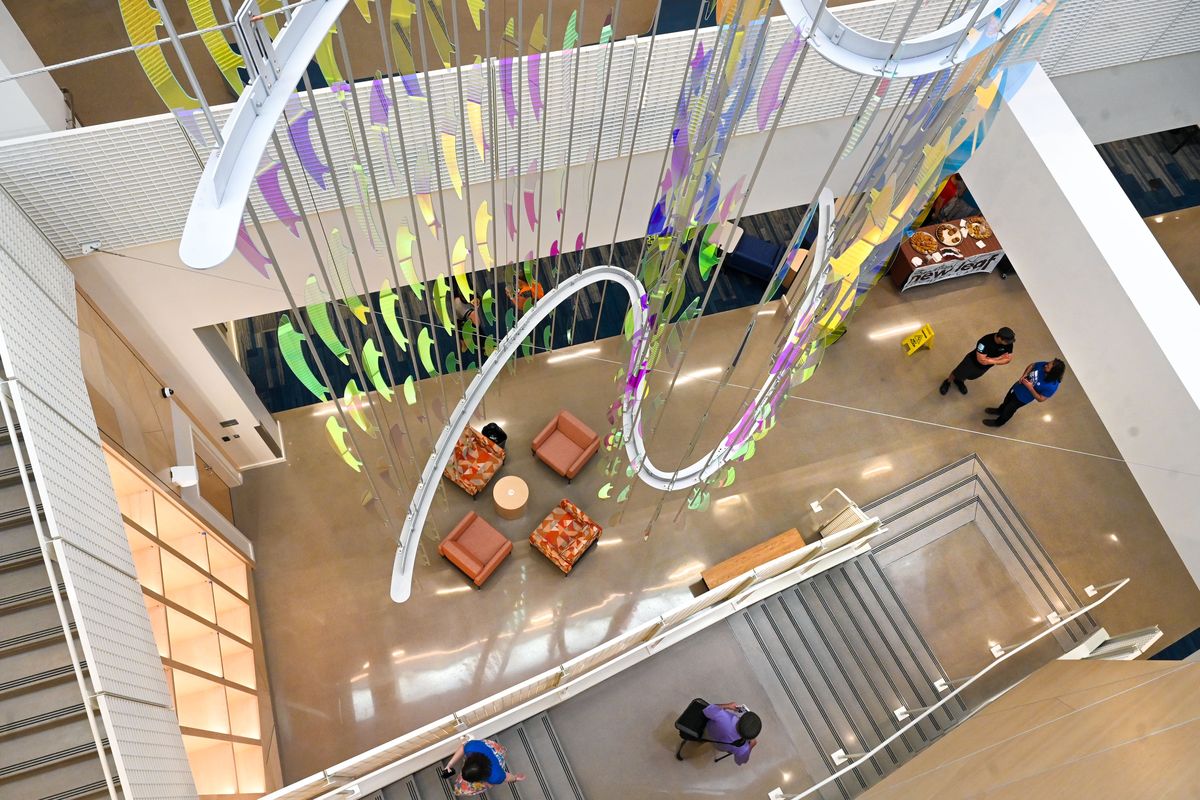‘Shimmer’ lights up the new Central Library in downtown Spokane

As part of its recent remodel, the Spokane Central Library is home to a new public art piece, “Shimmer.”
Created by Portland artist John Rogers, the piece hangs from the ceiling of the library, passing through each floor and scattering colorful light throughout the building.
The process of constructing and designing “Shimmer” allowed Rogers to explore all the possibilities for the spaces in the library. Eventually, he settled on a design that would work in the middle of the library, with the central stairway winding its way around it.
“All my designs are a response to the architectural space they’re in,” he said. “Basically, what I do is I visit the site, then build a model, then work on something that goes with the architecture.”
At first, he intended to hang glass-clad poles off an oval-shaped piece of steel, but he changed his mind when his wife suggested he use a more fluid shape. The final design features an S-shaped skeleton, guiding the poles from floor to floor.
“Later I thought, ‘Oh wait, it’s Spokane and these are S’s!” he said. “The glass is kind of like the frosting on the cake.”
The colorful shapes featured in Rogers’ piece are made from dichroic glass, which reflects a variety of different colors depending on the angle and the lighting.
“It’s really active media,” he said. “It puts a lot of color in the space.”
The piece was chosen with the help of a panel made up of people from Spokane Arts, members of the public, and representatives from Spokane Public Library. For some of them, the colorful and fluid nature of the sculpture evoked the Spokane River, with its fish-shaped glass pieces and flowing, waterfall-like length.
“The group really loved that it reminded them of the river, because of the location of this branch and the importance of the river,” said Spokane Art’s Melissa Huggins, who helped oversee the committee that selected Rogers’ piece.
Although he didn’t initially set out to create a river-themed piece, Rogers embraced a fin-shaped design for the glass he used. Each “fin” is attached to a long vertical pole, and each pole is attached to the S-piece at the top.
That’s what gives it that shape, sort of like an animal or a salmon going up the tube,” he said. “It wasn’t like, ‘Oh, let’s make this look like a salmon.’ It was just the shapes I like.”
In fact, the aquatic visual didn’t dawn on him until he began assembling the pieces in the library.
“When my helper, Hans, and I were putting it up, he said ‘Hey, this looks kind of like salmon going over the falls,’” he said. “I was like ‘What?!’ ”
Rogers isn’t the only artist with a public piece on display at one of Spokane’s public libraries. In fact, both Liberty Park and Shadle Park recently gained public art pieces from regional artists.
When the library remodel bond was approved in 2018, 1% of the money received was set aside for art at the libraries. Both Shadle Park and Liberty Park also received large public art pieces, and each library now has a rotating gallery of two-dimensional pieces from local artists.
Spokane Public Library’s arts education specialist Eva Silverstone helps curate the local art galleries. She was also a representative for the library on the selection committee for “Shimmer.”
“I’m a strong believer that art shouldn’t just be for people who feel comfortable in museums or galleries,” she said. “It should be for everyone.”
The Central Library sits downtown at 906 W. Main Ave. At any given moment, there’s a diverse crowd of people enjoying the quiet, peaceful place. The art in the library is only one component of its appeal, but it’s a powerful one.
“Everybody can enjoy art,” Silverstone said. “You don’t have to be a reader to enjoy art. You don’t have to be from a certain place to enjoy art. Art transcends that.”
Rogers agrees.
“I don’t want to be too literal,” he said. “I want the work to be as open to as many interpretations as people could have.”